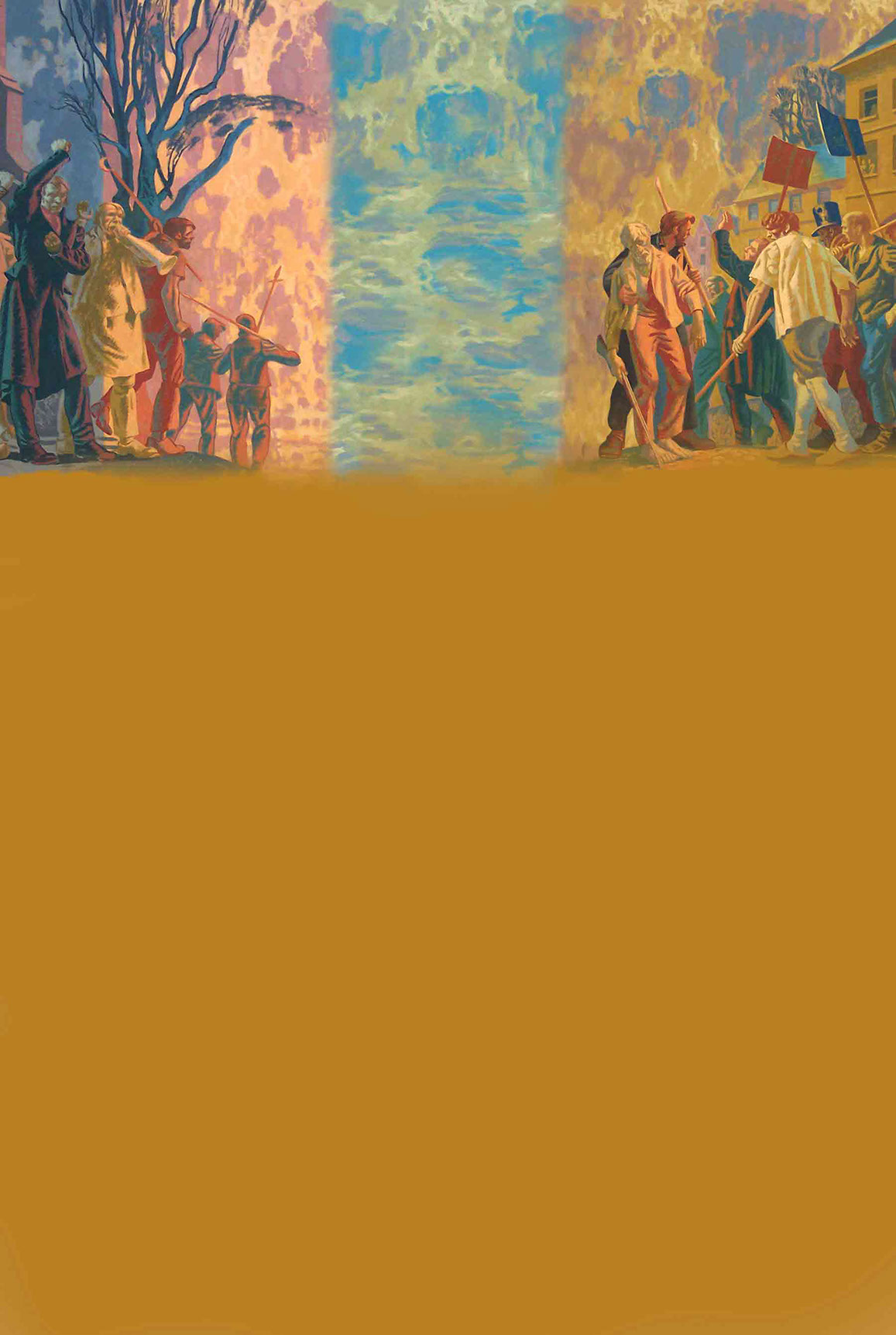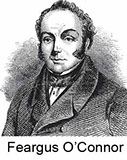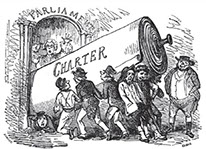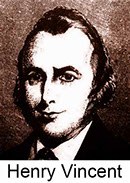
Did 1839 change history?
A lecture by Prof. Chris Williams given at the 2015 Chartist Convention at St. Woolos Cathedral Newport
The Chartist movement was a nationwide coming together of millions of working people, leavened with elements of the middle classes, who campaigned, for more than a generation from the late 1830s through to the 1840s for what we would understand today as many of the key elements of modern democracy. Chartism has been termed by the distinguished historian Asa Briggs ‘the greatest movement of popular protest in British history’(1). Because the vast bulk of its supporters did not enjoy the parliamentary vote the movement struggled to find an effective strategy, wavering between peaceful petitioning and more threatening mass intimidation or even proto-revolutionary violence. It enjoyed three peaks of support – in 1839, 1842 and 1848 – but on each occasion found itself unable to make progress in the face of both the resistance of the political establishment and its own divided counsels. Eventually it petered out as its members followed other paths to a better future.
The question that I am addressing this afternoon is whether the events of the first of those peaks of support – in the year 1839 – changed history. It’s not exactly the calendar year: I’m taking a twelve month period stretching from the assembly of the General Convention of the Industrious Classes in London on 4 February 1839 to the commutation of the sentences passed on the Welsh Chartist leaders of the Newport Rising on 1 February 1840. My question is whether the events of that year materially affected the course of the political and social history of Britain. Initially, I have to admit that I was thinking of ‘1839’ purely in terms of the Rising itself. But as I have thought further about this subject, so I have felt that it is more appropriate to consider the entire year, of which the Rising and its aftermath was a tragic climax, or anti-climax. And by looking at the events of the year, rather than of a few days in November, one is forced to approach the subject from a British perspective rather than isolate the specifically Welsh or Newport context from its wider moorings.
 As 1839 opened the Chartists had every reason to be optimistic about what it would bring. They knew that it would be a critical year. Indeed, Feargus O’Connor, at a meeting of the Birmingham Political Union on 13 November 1838, had declared that were the Charter not obtained by 29 September 1839, all moral agitation would come to an end and other measures be taken to effect the movement’s goals. It was going to be a year, to use a colloquialism, of ‘win or bust’.
As 1839 opened the Chartists had every reason to be optimistic about what it would bring. They knew that it would be a critical year. Indeed, Feargus O’Connor, at a meeting of the Birmingham Political Union on 13 November 1838, had declared that were the Charter not obtained by 29 September 1839, all moral agitation would come to an end and other measures be taken to effect the movement’s goals. It was going to be a year, to use a colloquialism, of ‘win or bust’.
Chartism’s objectives were already in place: both the People’s Charter and the National Petition had been published the previous May, and a large number of signatures to the latter had already been collected. There had been extensive preparation and building of the movement’s infrastructure: the Chartist press, headed by the Leeds-based Northern Star, was flourishing, and it went on to hit a circulation high of 50,000 in 1839 (weekly sales averaged 36,000 during the whole year). At this time had the largest circulation of any provincial weekly and in August 1839 was outselling The Times.
Across the land political unions had been established. There had been many large mass meetings (sometimes running into tens or even hundreds of thousands) at which the principles of the Charter had been explained, often by itinerant Chartist speakers or ‘missionaries’, such as Henry Vincent, who was especially popular in south west England and South Wales. Delegates to the forthcoming General Convention of the Industrious Classes – the Chartists’ alternative Parliament, if you like – had been elected, and substantial sums of money (£1350) had been raised to cover their and the Convention’s costs.
Chartists felt, as the Convention met at the British Hotel, Cockspur Street in Charing Cross on 4 February 1839, that they occupied the moral high ground in their anticipated trial of strength with Parliament. The Convention’s opening was timed to coincide with the beginning of the new parliamentary session, and its rigorous procedures and sense of its own importance were entirely appropriate for a body that felt itself to be far more representative of public opinion than a Commons elected by, at most, 800,000 men of means and privilege. Delegates wrote ‘MC’ after their names rather than MP, and an invitation was issued to the Commons to meet the Convention at the Crown and Anchor Tavern on 27 February. It was not taken up.
How did the Chartists attempt to realise their objectives? They had to put pressure on Parliament rather than expect to mobilise support within the Commons, for there was very limited sympathy amongst MPs for the Six Points. So the strategy was to try to impress Parliament with the force of public support.
 This could be done by presenting a petition, a time-honoured method carried to an all-time historical high (the 1.28m signatures on the 1839 comfortably exceeded the total of any previous petition presented to Parliament). During the campaign for Catholic emancipation in the 1820s, such peaceful agitation had ultimately been successful, and during the Reform Crisis of the early 1830s popular leverage had been mobilised in the form of mass demonstrations sometimes accompanied by rioting. These were precedents on which the Chartists drew, although in both cases such external pressure had been accompanied by considerable support for change within the political nation.
This could be done by presenting a petition, a time-honoured method carried to an all-time historical high (the 1.28m signatures on the 1839 comfortably exceeded the total of any previous petition presented to Parliament). During the campaign for Catholic emancipation in the 1820s, such peaceful agitation had ultimately been successful, and during the Reform Crisis of the early 1830s popular leverage had been mobilised in the form of mass demonstrations sometimes accompanied by rioting. These were precedents on which the Chartists drew, although in both cases such external pressure had been accompanied by considerable support for change within the political nation.
Between 4 February and 6 September the Convention sat, variously in London and in Birmingham, and represented, at least theoretically, the sovereign power of the Chartist movement. Most Chartists put their faith in its ability to navigate the realisation of the six points. During this time it oversaw the finalisation of the National Petition and its transfer on 7 May to sympathetic radical MPs (Thomas Attwood of Birmingham and John Fielden of Oldham) who were to present it to Parliament (this duly took place on 14 June). The Convention also debated possible courses of action – ‘ulterior measures’ - should the petition be rejected by the Commons, as was widely predicted. Unfortunately it had great difficulty in reaching consensus on a course of action, and was beset by various controversies, often centred on responses to threats of violence or outbreaks of civil disorder, as occurred in Llanidloes in April and May 1839 and in the Bull ring in Birmingham in July. This meant that when the Commons rejected the motion to establish a committee of the whole House to consider the first National Petition by 235 votes to 46 on 12 July, the Convention had no immediate or convincing response.
Indeed, when the ruling classes refused to be intimidated and rejected the national petition in 1839, the Chartists’ bluff was called. The discussion of ‘ulterior measures’ encompassed a general strike (‘the sacred month’), the withdrawal of funds from the banks to precipitate a financial crisis, refusing to buy taxed goods, and exclusive dealing / trading with sympathetic s hopkeepers only, but there was no agreement on how to proceed, and proposals to begin a ‘sacred month’ were eventually set aside for three days of protest meetings, but there was considerable disorientation and division among the Chartist leadership as to how to proceed, a situation exacerbated by the arrest and imprisonment of a number of prominent figures in the movement, including Joseph Rayner Stephens, Henry Vincent, William Lovett and John Collins. J. T. Ward, a relatively unsympathetic historian of Chartism, suggests that the movement ‘disintegrated’ in the summer of 1839, the Convention breaking up in disorder on 6 September, but it is difficult to disagree with him. (2)
hopkeepers only, but there was no agreement on how to proceed, and proposals to begin a ‘sacred month’ were eventually set aside for three days of protest meetings, but there was considerable disorientation and division among the Chartist leadership as to how to proceed, a situation exacerbated by the arrest and imprisonment of a number of prominent figures in the movement, including Joseph Rayner Stephens, Henry Vincent, William Lovett and John Collins. J. T. Ward, a relatively unsympathetic historian of Chartism, suggests that the movement ‘disintegrated’ in the summer of 1839, the Convention breaking up in disorder on 6 September, but it is difficult to disagree with him. (2)
What followed in the autumn and early winter of 1839 was a period of great tension, with the authorities becoming more active in harassing, restricting and arresting Chartist activists, and certain Chartist leaders responding with inflammatory rhetoric and, evidently, plans for insurrections of various designs. This came to a head with the Newport Rising of Sunday 3rd and Monday 4th November. This was the most serious manifestation of physical force Chartism in the history of the movement. The Battle of the Westgate clearly resulted in the defeat and confusion of the Chartists and, whatever rose-tinted romantic spectacles we might view it through today, it ended in a disastrous failure that completely discredited any insurrectionary strategy and alienated many potential allies.
The trial for high treason of the Rising’s leaders (which began in December), their conviction (in early January 1840), and the commutation on 1 February of the death sentences passed on 19 January to transportation to Australia, went some way towards rescuing the ‘cause’ of Chartism in that it highlighted the dignity of John Frost in particular, and mobilised sympathy for those on trial. It also clouded the historical record in that the defence case sought to deny that the Rising had been a genuine attempt at insurrection, instead preferring to characterise it as a ‘riot’, which was a less serious crime than treason. Frost and his colleagues declared that they had ‘never entertained any feeling or spirit of hostility against your Majesty’s sacred person, rights, or immunities, nor against the Constitution of your Majesty’s realms as by law established.’ [3]
It was in the interests of key parties to maintain a ‘conspiracy of silence’: the Chartist leaders in order to give themselves the best chance of avoiding conviction and possibly a capital sentence, and the Government in order to play down the seriousness of the threat. Even Chartist leaders not implicated in the rising who had been prepared to contemplate insurrection or forcible resistance tended to revise their views after Newport, and in subsequent memoirs and correspondence suppress this aspect of their beliefs.
Whatever the motives of those involved in the Newport Rising, there was no denying that it set the Chartist movement back very considerably. Many Chartists at the time were deeply embarrassed and saddened by what happened here. Malcolm Chase has written that ‘a feeling of numbed incredulity assailed Chartists’ once they found out about events.[4] According to the Western Vindicator of 30 November:
We regret they [the Welsh Chartists] should have given vent to their feelings in the way they have, because it was in no way calculated to forward the cause of the People’s Charter. [5]
The Rising was condemned widely, and not only by hostile commentators. Previously sympathetic newspapers such as the Silurian and the Cambrian backed away from the movement. Ryland Wallace’s judgement is that ‘the transportation and imprisonment of many Chartist activists did much to weaken the cause, while the experience, or the fear, of a rigorous gaol sentence … also … served to dampen ardour.’ [6]
An early historian of Chartism, Mark Hovell, was even more forthright, stating that ‘Chartism never again attained the extent and dimensions it possessed in 1839’.[7] Chartism was forced onto the defensive by the Rising and the trials. Instead of petitioning for the six points Chartists were reduced to petitioning for mercy for its gaoled leaders. For a while there was a vacuum at the heart of the movement, the Chartists were confused, disorganised, and many left the movement altogether, or went undercover. As Dorothy Thompson noted, for ‘radicals of the Jacobin type, who had seen Chartism as an extension of the movement for political reform which had achieved political success in 1832, with its threats of armed action being essentially a tactic, Newport was a watershed. They saw here a form of radicalism which they neither understood nor approved.’ [8]
1839 was, clearly, a momentous year in the history of Chartism. There were to be two others – in 1842 and in 1848 – but in neither case, I would suggest, would the movement be so optimistic, so convinced of its own destiny and that the tide of history was in its favour.
What I wish to do now is to attempt to evaluate the arguments for and against seeing 1839 as critical. Did what happened during that year make a clear and measurable difference to historical outcomes? Did 1839 change history?
It is clearly possible to argue that it did not. There is one key point to be made here. It is worth considering whether, notwithstanding its widespread popularity, its early momentum and its (perhaps misplaced) self-confidence, Chartism ever stood any real chance of achieving its objectives. The state was relatively united in opposition to it, as were the middle and upper classes. There was very limited support for the Charter within Parliament (unlike during the Reform Crisis of the early 1830s when the governing class was split) and, so long as the government held its nerve, it was difficult to see how the Chartists might have won. Unless the entire political establishment lost its nerve the Charter was unattainable. And, notwithstanding the insurrectionary fantasies of some on the extreme wing of the Chartist movement, this was highly unlikely. So the cards were heavily stacked against Chartist success from the very beginning.
It could be suggested that Chartism’s only hope of a positive outcome in its own time was to achieve its goals incrementally. But it never developed a sufficiently coherent political strategy for managing this and was temperamentally disinclined to shelve its more expansive ambitions.
It was, furthermore, unable to build bridges with middle-class reforming movements. At some level this was because many Chartists were deeply opposed to what the middle classes represented. The Poor Man’s Guardian had argued that:
The middle classes are the real tyrants of the country … the authors of our slavery; for without their connivance … no tyranny could exist. Government is but a tool in their hands to execute their nefarious purposes. [9]
But without a viable political strategy to split the Liberals and the middle classes from the aristocracy and the Tories the movement ultimately lost momentum and fizzled out. It united against it both middle-class reformers and upper-class aristocrats, both Liberals and Tories, both Nonconformists and Anglicans. Not all who opposed Chartism were reactionaries in their politics. More limited electoral reforms (as witnessed in the Second Reform Act of 1867) were less than a generation away, stimulated by the Reform League (established in 1865 to press for manhood suffrage and the ballot) which owed much to Chartist ambitions and post-Chartist energies, but worked in tandem with middle-class radicals. Ultimately the demand for admission to the political nation did not go away. But the Chartists wanted too much, too soon, and the urgency and the impatience of their demands were not calculated to receive the most welcoming response from those who held the reins of political power.
It is difficult to gainsay much of the force of the foregoing argument yet, is there a way in which, nonetheless, we can see 1839 as some sort of turning-point? I want to make two points here.
The first is that the failure of the Newport Rising clearly discredited the insurrectionary strategy which occupied a somewhat marginal or uncertain position within Chartist counsels. Malcolm Chase, in the most recent and most authoritative history of the movement, has reminded us of the difference between genuine insurrectionary intent and what he calls ‘loose talk’. He characterises Henry Vincent’s observation at Blackwood in March 1839 that ‘a few thousand armed men’ in the hills could successfully defend South Wales and that it would make ‘an excellent republic’ as ‘clearly loose talk’, a judgement that is implicitly critical of Ivor Wilks’s use of exactly the same speech to build the objective of a Silurian Republic out of a house of rhetorical cards. [10]
We need to remind ourself that the dynamic between peaceful petitioning and the threat of violence is complex and easily misunderstood. It has traditionally been characterised as a division between ‘moral force’ and ‘physical force’, but the reality is more subtle. There were Chartists who believed that success could only come by building coalition with middle-class reformers, and for that to be possible violence had to be avoided. As William Lovett argued:
Instead of spending a pound on a useless musket, I would like to see it spent in sending out delegates among the people … Whatever is gained by force, must be sustained by force, but whatever springs from knowledge and justice will sustain itself. [11]
At the opposite extreme were those who believed that violent revolution was the only way to achieve the Charter and its associated goals. George Julian Harney declared that ‘There is not an argument like the sword, and the musket is unanswerable’.[12] Most Chartists occupied an intermediate position. Some felt the rhetoric of violence and the momentous demonstration of popular power through marches and demonstrations would be sufficient to frighten the government into concessions. Violence was not seriously advocated, but the threat of violence was part of a massive game of bluff.
Many Chartists in fact believed that violence would most likely come from the government, in a repetition of the Peterloo massacre of 1819 (when yeomanry broke up a radical reform meeting in Manchester of over 60,000 people, leaving 11 dead and over 400 wounded) that would shift public opinion towards the Chartists, and provoke widespread uprisings that would topple the government in a political crisis rather than necessarily as part of a violent revolution.
Actually the authorities were very careful not to provoke a clash, and the Chartists themselves, here initiated the only armed confrontation, at Newport. Both the Home Secretary (for most of this period – Lord John Russell) and Major General Sir Charles Napier (in charge of the army in the Northern District of England) were determined to avoid bloodshed and to restrain local magistrates who tended to exaggerate the threat and want to stamp down hard on the Chartists.
So the governing classes and the state were largely united, both highly resistant to peaceful persuasion, and also sufficiently in command of the powers of coercion to be able to withstand Chartist pressure and intimidatory rhetoric. The loyalty of the army was never in serious doubt, and although the state was capable of acting forcefully, enlisting special constables and arresting about five hundred Chartists in 1839 on charges ranging from seditious utterance, seditious libel, incitement, drilling, and conspiracy all the way up to high treason, it was also careful not to over-react and thus run the risk of provoking greater public support for the Charter than already existed.
The transportation of the Newport Chartists, rather than their martyring by carrying out the sentences of death originally passed on them, is perhaps the best example of the British state’s common sense approach, reinforcing the positive context for moderate Chartism while closing off the insurrectionary option, avoiding the true martyrdom of Frost, Williams and Jones which might have sown a legacy of bitterness towards the state amongst the working classes.
With the insurrectionary strategy discredited, the Chartists’ response (once they recovered from the shock and disappointment of 1839) was to organise for the long haul rather than the quick revolution, forming the National Charter Association in July 1840, and returning to peaceful petitioning (although there were still occasional outbreaks of violence as in 1842 and 1848). The NCA became the first working-class political party in the world, with national and local elected officials and with 350 branches in existence by 1842. Chartism also developed a democratic, radical sub-culture, strengthening a sense of the movement as a self-sufficient environment for working-class people, resistant to middle-class moralizing norms.
There were Chartist churches (Jesus was seen as the first Chartist), Chartist temperance societies, coffee houses and Chartist pubs. Chartist boarding houses were set up for itinerant lecturers and Chartist Halls of the People opened in Manchester, Leeds, Birmingham, Newcastle and Oldham. There were Chartist schools, libraries, evening classes, Chartist celebrations of the birthdays of radical heroes such as Henry ‘Orator’ Hunt and Thomas Paine, or markings of the anniversary of the Peterloo massacre. There were Chartist brass bands, choirs, orchestras, dances, theatre, Chartist sports teams and even Chartist funerals. The visual iconography of Chartism was highly developed, with the symbolic use by leaders of working men’s clothes and of flags, banners, caps of liberty, scarves, sashes and rosettes. In the Chartist movement members found a fiercely independent sense of purpose and comradeship. The Chartist Land Plan, for all its unrealised ambition, was perhaps the most telling expression of this building of an alternative, radical and democratic culture.
Yet 1839 represented the only moment, it might be reasonably argued, that the Chartist movement could have achieved something political. After its defeat in that year, it became a defused, in some respects diffuse, sub-cultural protest movement, capable of further moments of threat and bluster, but without the capacity to articulate a convincing political strategy for change. As a consequence, it failed to achieve its objectives in its own lifetime. But does that mean, simply, that it was a failure? George Julian Harney stated in 1852:
Chartism itself will survive the wreck of parties and the ruin of politicians. Apparently it has fallen into contempt, and is nearly consigned to oblivion; but in truth its spirit has begun to exercise an influence over the country’s politics; and all parties have come to acknowledge the potency of that democratic opinion. [13]
Notwithstanding the movement’s disappointments, then, Chartism could claim a positive legacy. It schooled a generation of working men and women, the first in the world, in political activism. It established a pattern of local democratic involvement that fed into other movements such as trade unionism, friendly societies, the co-operatives, and adult education. It contributed to a common, nationwide historical tradition of radical activity that could be drawn on by later organisations. Its ethos – of committed, sincere, honest endeavour, of scrupulous organisation, adherence to procedure, the use of the committee structure – was one which permeated the culture of radical Liberalism, the socialist revival and the early phases of the Labour movement. Despite its flirtation with revolutionary methods, the approach of the Chartists remained essentially respectful of the rule of law and the principle of trial by jury, of the sovereignty of (ideally a reformed and representative) parliament, and of the institution of monarchy. Although there were elements of collectivist socialism in Chartism, there was an equal if not stronger identification with the rights and dignity of the individual.
Over time the achievement of five of the six points of the Charter may be thought to constitute what the German historian of the British Labour movement Max Beer called ‘the victory of the vanquished’, and it is easy to believe that these incremental gains would have taken longer without the precedent of Chartism. [14] Putting the reforms in a broader context, Mark Hovell noted that many minor points of the Chartist petition were realised, mostly designed to insulate electoral choice from bribery and corruption: the payment of returning officers for their services, the relegation to the rates of the necessary expenses of elections, the shortening of the period of voting to a single day, the veto of plural franchises. Even in 1918 he could write that ‘as far as political machinery goes the Chartists have substantially won their case.’ [15]
The Chartist movement was a noble episode in British history that continues to inspire through its idealism and its sense of what might have been.
Ordinary people spoke out for democracy and for freedom, and although they were not listened to at the time, their voices have echoed down the generations. 1839, in that sense, changed history, and changed it for the better.
_________________________________________________
1] Asa Briggs, Chartism (Sutton, Stroud, 1998), 1.
2] J. T. Ward, Chartism (Batsford, London, 1973), 133.
3] Cited in Ward, Chartism, 138.
4] Malcolm Chase, Chartism: A New History (Manchester University Press, Manchester, 2007), 127.
5] Cited in Ryland Wallace, ‘Organise! Organise! Organise!’ A Study of Reform Agitations in Wales, 1840-1886 (University of Wales Press, Cardiff, 1991), 35.
6] Ibid.
7] Mark Hovell, The Chartist Movement (Longmans, Green & Co, London, 1925), 187.
8] Dorothy Thompson, The Early Chartists (Macmillan, London, 1971), 27.
9] Poor Man’s Guardian, 17 August 1833.
10] Chase, Chartism, 106-7. Ivor Wilks, South Wales and the Rising of 1839: Class Struggle as Armed Struggle (Croom Helm, Beckenham, 1984).
11] Cited in David Jones, Chartism and the Chartists (Allen Lane, London, 1975), 151.
12] Cited in D. G. Wright, Popular Radicalism: The Working-Class Experience, 1780-1880 (Routledge, Abingdon, 2013), 120.
13] Cited in Ward, Chartism, 235.
14] Cited in Briggs, Chartism, 7.
15] Hovell, Chartist Movement, 302.






